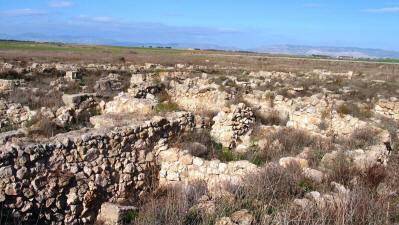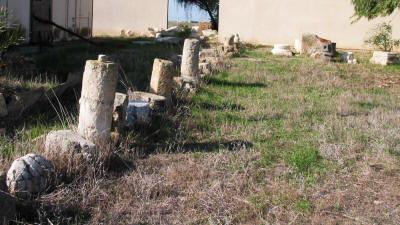Enkomi (Alasia)
Tuzla, Near Famagusta, North Cyprus
 |
| Enkomi Ruins |
The area around Famagusta has always been favourable to growth and prosperity.There was a fertile plain, and the bay of Salamis provided a natural harbour. Its gegraphical position, and the prevailing winds and currents in this part of the Mediterranean meant it was ideally located to provide an outlet for trade and cultural relations with the near east.
Archaeological excavations have shown that the earliest settlements in this area were made during the Middle Bronze age (2000BC to 1600BC), probably around 1800BC. The original settlement was on a rocky plateau west of Tuzla, on the north bank of the river Pedieos. Copper ore was transported to Enkomi, where it was smelted and shipped for export. At this time, the river was navigable, and Enkomi had an inland harbour. Metallurgical activities increased during the Late Bronze Age, during which time correspondence between the Pharaoh and the king of a country referred to as Alasia took place.
It is unclear whether Alasia refers to Enkomi, the city, or to Cyprus as a whole. The correspondence shows that Alasia was a supplier of copper to Syria and Anatolia, and excavations here have discovered several areas of the city where metallurgy took place. Copper oxide was discovered along with tools and waste products left over from the smelting process.
 |
| Columns Excavated from Enkomi |
About 1200BC, earthquakes destroyed most of the city which was rebuilt. The earlier town had been built on an ad hoc basis, but the new town was built on the grid system, with long east-west avenues and a perpendicular main street. Older structures and tombs were covered over or removed.
Most of surviving ruins are from the rebuilt city, which never really recovered its ancient grandeur. By then its ancient harbour was already silting up, and an earthquake in 1075BC further raised the river bed. Its last inhabitants are thought to have moved closer to the sea to found Salamis.
The town was first excavated towards the end of the Ottoman period. However, the British stopped this. It was next excavated by a team from the British Museum in 1896 when a number of tombs were opened. Further excavations took place in 1913 and 1930. In the 1940s, the site of the palace was discovered. Some excavation continued after then, but they were discontinued in 1974, and threats from the authorities in the south have meant that no further excavation has been possible.
Discoveries included a horned god, possibly depicting Apollo, and a silver bowl inlaid with floral and ox-head designs. These, and other finds are now in the British Museum and the Cyprus Museum in south Cyprus. Some other finds can by seen where they were left by the archaeologists near the semi-abandoned excavation warehouses at the entrance of the site.
See the location in Google maps.
Return to Salamis Index or Famagusta Index.